Great white sharks are one of the most iconic animals in the world. Their size, strength, and aggressive nature have made them a subject of fascination (and fear) for humans for years.
Despite their size and power, great white sharks are threatened by various factors. This has caused populations to decline dramatically. Great white sharks are classified as”Vulnerable” on the International Union for Conservation of Nature (IUCN) Red List. That’s one step below endangered, and its population is still decreasing. They are also categorized as Moderately Depleted in the IUCN Species Recovery.
- Status: Vulnerable
- Known as: Great White Shark, White Shark, Great White, White Death, White Pointer, and Lesser white shark.
- Estimated numbers left in the wild: Unknown, possibly less than 3,500.
But why are they considered vulnerable? It’s likely because of how much we hunt them—and how little we know about them! Great whites have been hunted for their jaws, fins (to make shark fin soup), and meat.
These sharks are also threatened by accidental catches such as bycatch in fishing gear. Conservation efforts are underway to help protect this iconic predator of the sea.
So, is the Great White Shark endangered?
Description
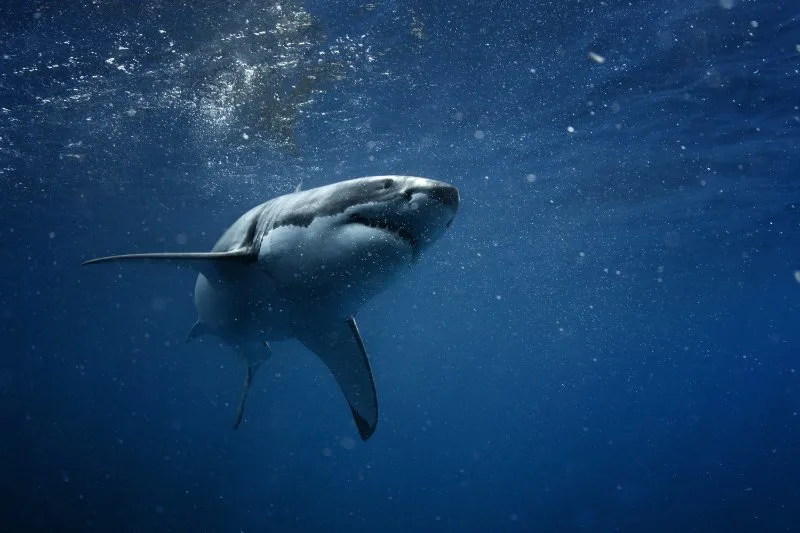
The Great White Shark (Carcharodon carcharias) gets its name from its mostly white coloring. The marine mammal is called White pointers, Carcharodon carcharias, and Great White.
The Great White Shark is a member of the Lamnidae family, which includes Salmon sharks and Mako sharks.
These sharks are an extremely widespread species found throughout the world in temperate and subtropical seas. As a predator, white sharks are at the peak food chain and play a vital ecological role in the marine environment.
Known as an iconic genus, occurrences occur in nearshore habitats and are frequently seen in films or documentaries.
Despite the fearful reputation, the shark’s large size makes its reproductive capacity vulnerable to declining populations due to human impact.
The white shark has a wide range of biological weaknesses and can be regarded internationally as one of the very vulnerable species. This species of shark is one of the most fearsome predators in the sea. Great whites are known for their size, powerful jaws, and sharp teeth.
Great whites are also a vulnerable species with a population of fewer than 3,500 individuals worldwide. Great whites have been hunted for their jaws, fins (to make shark fin soup), and meat.
Anatomy and Appearance
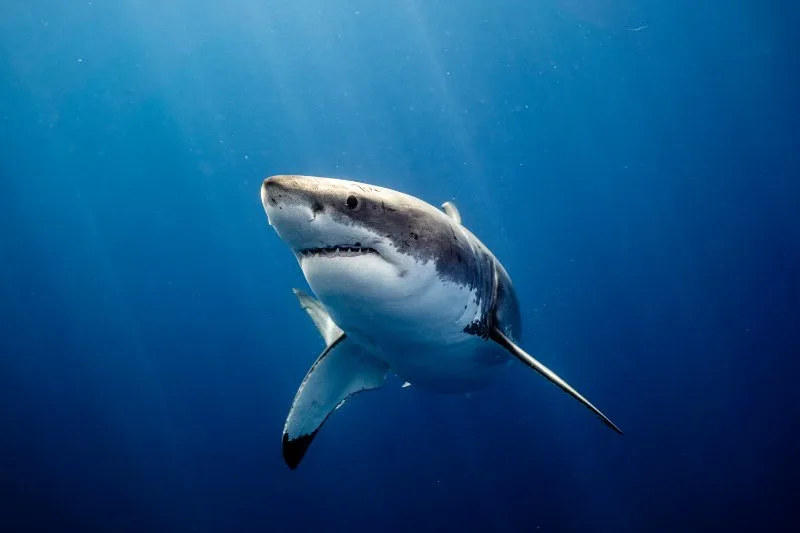
Great whites are believed to have evolved around 100 million years ago from a prehistoric ancestor that was also a shark.
These vulnerable shark species are one of the most primitive living sharks and have remained largely unchanged for millions of years. Great white sharks have a skeleton made of cartilage, which is much softer than bone. This allows these predator sharks to move more easily through the water.
The great white shark is a large oceanic apex predator, measuring up to 6 meters long. They can weigh up to 2,400 pounds and grow as long as 20 feet. And these marine mammals are the largest predatory fish in the world.
The average size of a great white shark is about 15 feet long and 1,500 pounds. Great whites can reach up to 6,000 pounds and are 23 feet long.
These marine animals are efficient predators, with powerful jaws and around 300 serrated teeth, which can chop off a huge chunk of whatever they bite.
The difference between female and male great white is that the male is usually larger than the female. The male Great Whites also have larger claspers – the pair of organs used for mating.
The great white shark’s snout is broad and conical and strong and sturdy. Similarly to mackerel sharks, this species’ top and lower lobes on the tail fin are around the same size.
The great white shark is countershaded, with a white underbelly and a grey dorsal portion (occasionally in a brown or blue hue) that creates a mottled look. Since the coloring disrupts the shark’s contour, it’s harder for prey to notice it. The darker color blends in with the ocean from above, while the lighter color reveals a basic outline against the sun from below.
Like many other sharks, great whites have 5 rows of serrated teeth behind the main ones. Great whites are also known for their powerful jaws.
Like other mackerel sharks, the great white’s eyes are disproportionately huge compared to the rest of its body. The eye’s iris is a rich blue color rather than black. They have eyelids, but they do not have external ears.
These apex predators live in the world’s oceans but prefer temperate and cold waters. Great white sharks migrate long distances and can travel up to 10,000 miles a year.
These sharks are the top predators in the ocean, and they help keep the marine ecosystem balanced.
See Related: Why Were Animals So Big in the Past?
Location
Great white shark distribution is found around the whole globe, though they avoid the Arctic, Antarctic waters, Pacific coast, and the surrounding waters. These sharks live in coastal waters where the water temperature ranges from 12°C to 24°C.
Great White Shark Habitat
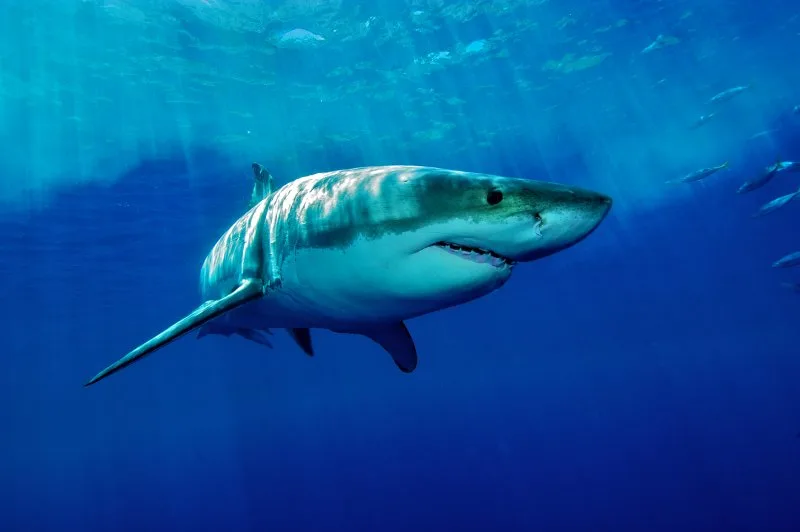
Great white sharks are found in temperate coastal waters all around the world.
Great whites prefer cool, clear waters where they can hunt prey. The white shark migrates to warmer waters during the winter months. Great white sharks can be found in both salt and fresh water.
However, there are also enough sightings of great whites deep in the open ocean to suggest that it is not just a coastal species. They also appear to migrate, though the reasons are unknown.
Great White Shark Adaptation
Sharks, including great whites, are equipped with an extra sense called ampullae of Lorenzini. This allows them to pick up on the electromagnetic field given off by the motion of living creatures.
The great white can detect voltage changes as little as half a billionth of a volt. This helps the shark find stationary prey by listening to their heartbeats at close range. Most fish, though, use their lateral line to generate a sensation that is comparable but less refined.
The great white shark has developed to keep its body warmer than the surrounding water. This is so that it may more effectively hunt swift and agile prey such as sea lions. A “rete mirabile” is one such modification.
This close web-like network of veins and arteries along each lateral side of the shark conserves heat. It does so by mixing cooler arterial blood with working muscle-warmed venous blood. The heart and gills can stay at sea temperature whereas other parts of the body can be kept up to 14°C above the water.
To save energy, the body’s internal temperature will drop to that of its environment. This phenomenon can be seen in the great white shark’s ability to increase its body temperature. Since the great white shark’s body temperature is not constant but is internally regulated, it can be classified as an endothermic poikilotherm or mesotherm.
When making long journeys across nutrient-poor ocean regions, great whites rely on the fat and oils stored in their livers. In addition to regulating the sharks’ buoyancy, the liver of great whites is critical in determining where they go during migration. Sharks that sink more quickly during drift dives deplete their energy reserves more quickly than those that sink more slowly.
See Related: Is a Fish an Animal? Here’s What You Need to Know
Great White Shark Diet and Nutrition
Great whites do not deliberately prey on humans but may take a “sample bite” in passing.
These sharks are carnivores and eat a variety of prey, including fish, marine mammals, and seabirds. White shark has very powerful and large bite and can easily take down large prey using their sharp upper and lower teeth.
Great whites usually hunt seals, sea lions, and dolphins but will also take advantage of injured or weakened animals. These marine apex predators have also been known to scavenge dead animals. Great white sharks are apex predators and have no natural predators themselves.
These predator marine animals are one of the most iconic and feared predators in the sea. These apex predators are known for their size, powerful jaws, and sharp teeth.
The White shark is also known to be an endangered species with a population of fewer than 3,500 individuals throughout the world.
Great whites have been hunted for their jaws, fins (to make shark fin soup), and meat. These apex predators are also threatened by accidental catches such as bycatch in fishing gear. Conservation efforts are underway to help protect this iconic predator of the sea.
See Related: Black Tip Sharks: Are They Endangered?
Hunting
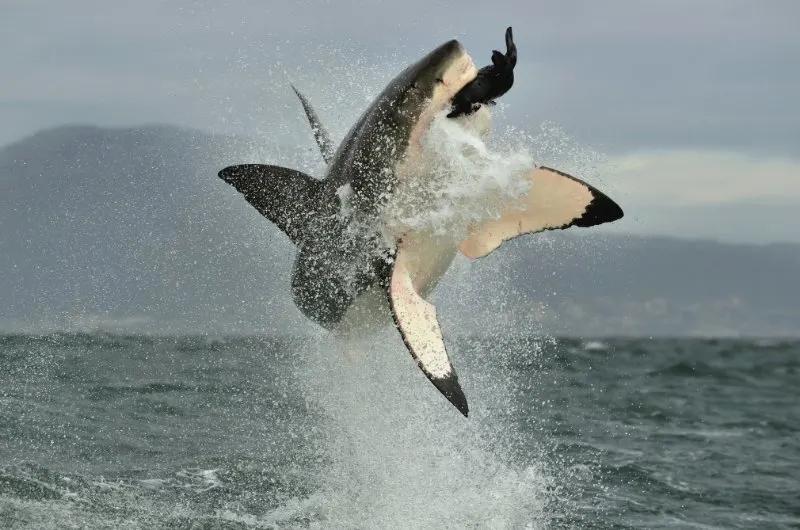
The senses of the white shark are extremely keen. This helps them find their prey since these sharks need to locate enough food to keep them alive in the ocean’s vastness.
Their ability to smell blood has become legendary, and with reason – a great white can detect one drop of blood in 100 liters of water and can smell larger blood concentrations from up to 5 kilometers away. Another sense at their disposal allows them to pick up the electrical field of a living creature and pinpoint their prey in this way.
These sharks are amazingly adapted to their habitat and can leap clear of the water in search of prey – a maneuver called “breaching.” This allows them to snatch seals, seabirds flying low over the water, and fish that attempt to escape by jumping clear of the surface.
The torpedo-shaped body of a great white makes it a quick swimmer, reaching speeds of 24 kilometers per hour. These sharks give birth to live young, known as pups. Their slow reproduction rate is necessary for their large size and metabolic rate but hampers efforts at recovery.
Predator
Great sharks have few predators, but orcas are known to hunt them. Where great white sharks and orcas share a common food, interspecific competition is likely to occur. All the great whites in the area likely fled at the sight of the dead shark, missing out on a tasty seasonal treat.
Great white shark populations can also be affected by orcas. Yet, on rare occasions, great whites have been observed swimming confidently within yards of orcas. Great whites are also preyed on by tiger sharks and large crocodiles.
Great White Shark Mating Habits
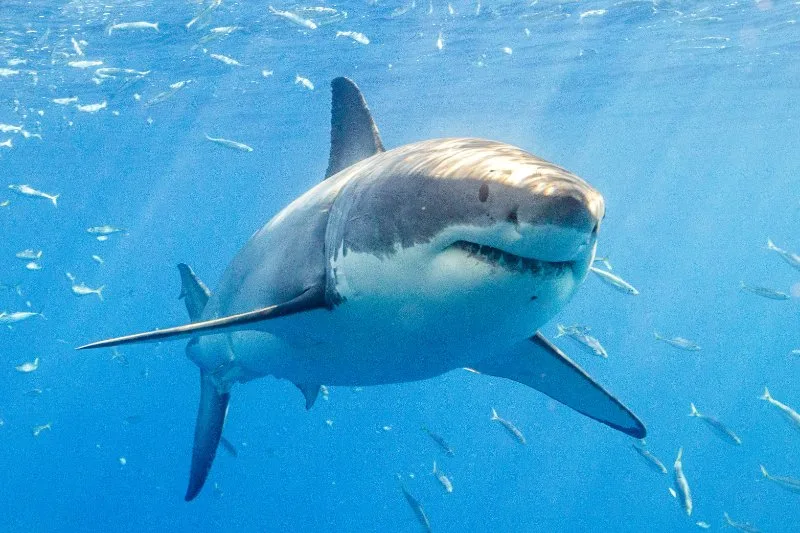
Great white sharks’ mating habits are a bit of a mystery to scientists. These apex predators are known to be solitary animals, but during mating season, they will come together in groups.
Scientists aren’t sure why Great whites congregate during mating season, but they believe it may have something to do with the fact that Great whites have a low reproductive rate. These marine predator sharks give birth to about 10-15 pups at a time, and those pups are born ready to start hunting on their own.
The mating season for Great whites is typically in the late winter or early spring. Scientists believe that the sharks may mate offshore in deeper waters, but they’re not sure. After mating, the apex predators will separate until the next mating season.
The tiniest free shark known grew to around 16 kg and measured 1.25 meters long. White Pups from Turkey’s Aegean coast.
It’s thought to occur near the western coast of North America, where white babies give birth in the warm South Pacific ocean. The younger will eventually move to the north as it grows bigger.
In viviparous female eggs reside inside the egg’s spermatocyte, and the egg is stored within these embryos’ eggs, consuming yolks from a sperm sac.
These marine mammals have a gestation period of about 18 months. These marine predator animals are born live and fully developed mostly in North America’s east and west coasts. Litter size is usually between 2 and 10 pups, but some have been known to give birth to as many as 18 pups.
Great white sharks are born approximately 4 to 5 feet long and weigh around 25 pounds. Great white sharks are born into a litter of 2 to 14 pups. They have a fast growth rate and can reach maturity in as little as 10 years.
See Related: Dwarf Sperm Whales: Are they Endangered?
Behavior
The largest known species of shark, the great white shark, is also one of the most dangerous. It has an extraordinary sense of smell, which it uses to find blood and other energy sources in its habitat.
Great white sharks have several hunting behaviors that help them to survive and feed. Some of these behaviors include ambush hunting, tracking prey, and diving. These Predators are also known to be an endangered species.
Shark Attacks on Humans
Only 4 species of sharks have been linked to many deadly, unprovoked attacks on people, and the great white shark is one of them. Great white sharks are notorious for their aggressive behavior and attacks on humans.
They typically attack from below, striking their prey with their sharp teeth. They can become defensive or threatened if they feel in danger. There have been 272 confirmed unprovoked bite cases involving great white sharks since 2012. This makes them the shark species most responsible for human bites.
At least 74 unprovoked bite incidences resulting in human deaths have been documented involving great white sharks. Despite this, great whites rarely attack humans. It appeared that many of the cases were “test bites.” Great white sharks will grab a human or a surfboard to determine its identity. They have been observed test-biting buoys, debris, and other mysterious objects.
Great white sharks do not confuse humans for seals, despite widespread assumptions to the contrary. Many shark attacks occur in murky waters or other conditions that hinder the shark’s ability to see. There is evidence that this species does not enjoy the taste of people, or at least does not recognize it.
According to the study’s results, the objects’ value as prey can be determined after just one bite. Most humans don’t appeal to them because of their skeletons. Seals are a favorite because of their high fat and protein content.
There is evidence that many great white shark bite instances could be the result of mistaken identity. Sharks are likely colorblind and cannot see fine enough detail. They can’t determine whether the silhouette above them is a pinniped or a swimming human.
Because of the shark’s lengthy digestive process, a person is not suitable prey. There is a high proportion of bone to muscle and fat in the human body. As a result, great whites usually separated themselves from the situation after the initial bite was made. Rather than critical organ loss or complete ingestion, most deaths are the result of blood loss following the initial bite.
Some scientists have speculated that people can escape from sharks after the initial bite. The reason is not that sharks don’t like human meat. It is highly unusual for the prey of a great white shark to be able to get out of reach with the help of others, as humans can.
There are a few things you can do to reduce your risk of being attacked by a shark:
- Avoid swimming in areas where sharks are known to congregate, such as near seal colonies
- Do not enter the water if you are bleeding
- Avoid wearing bright colors or shiny jewelry
- Do not swim after dark
- Stay calm and move slowly if you see a shark
If you are ever attacked by a shark, try to fight back and make as much noise as possible.
Sharks are more likely to let go of their prey if they feel threatened or attacked. Remember, shark attacks are very rare, and most sharks are not interested in attacking humans only on extremely rare events.
Swimming in the ocean is a great way to experience the beauty and wonder of nature – just use caution and be aware of your surroundings.
See Related: Are Humans Animals? 15 Things to Know
White Shark Populations
Great White Shark populations have been on the decline for a while now. One of the main reasons is that they are often caught as bycatch by fishermen targeting other fish.
They are also killed because of fear and misunderstanding by humans. Great white sharks are an important part of the ocean’s ecosystem, and it is important to protect them.
See Related: Great Hammerhead Shark
Role in the Ecosystems
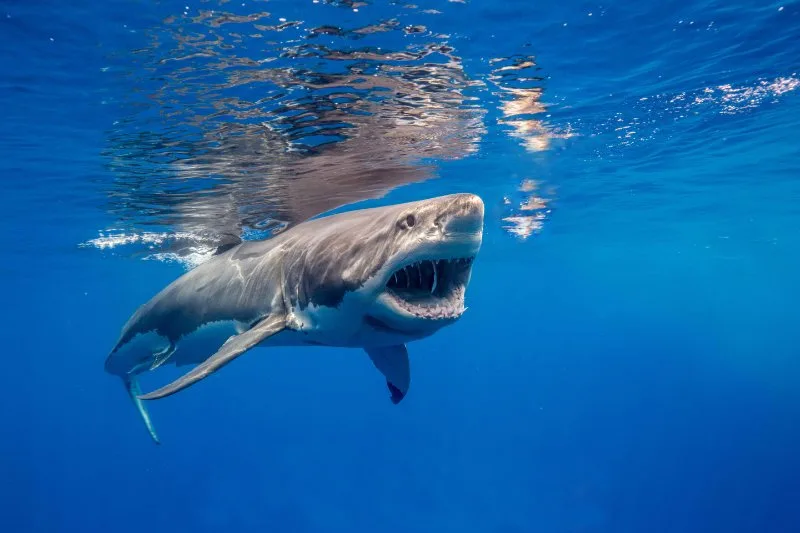
Great white sharks play a very important role in the ocean’s ecosystem. These marine mammals are infamously known as apex predators, meaning that they are at the top of the food chain.
This means that they help keep the populations of other animals in check. Great white sharks are also scavengers, meaning that they eat dead animals. This helps keep the ocean’s environment clean.
If Great White Sharks become extinct, the ocean’s ecosystem would be thrown off balance. Great white sharks are apex predators, meaning they are at the top of the food chain.
They keep the populations of other animals in check, which helps to maintain the balance of the ecosystem. If Great White Sharks were to disappear, it is likely that the populations of other animals would explode, which could cause the ecosystem to collapse.
In addition to their important role in the ocean’s ecosystem, Great White Sharks are also a tourist attraction. People travel from all over the world to see these amazing creatures in their natural habitat. If these apex predators were to disappear, this tourism industry would suffer a significant blow.
So, Great White Sharks are important both ecologically and economically. That is why it is so important to ensure that these animals do not become extinct.
Great White Shark vs Other Sharks
Great white sharks are distinguishable from other species of sharks because they are the only shark species that has a white underside. Great white sharks are also the largest predatory marine mammal in the world.
Other shark species are smaller and typically have darker coloring. Great white sharks are apex predators, meaning they are at the top of the food chain and have no predators.
Great white sharks have a varied diet that includes sea lions, seals, dolphins, porpoises, sea turtles, and even small whales.
One of the most distinguishing features of great white sharks is their size. These marine mammals can grow up to 20 feet in length and weigh up to 5,000 pounds.
Great white sharks are also known for their powerful jaws and sharp teeth. These features make great white sharks one of the most feared predators in the sea.
White Shark Species
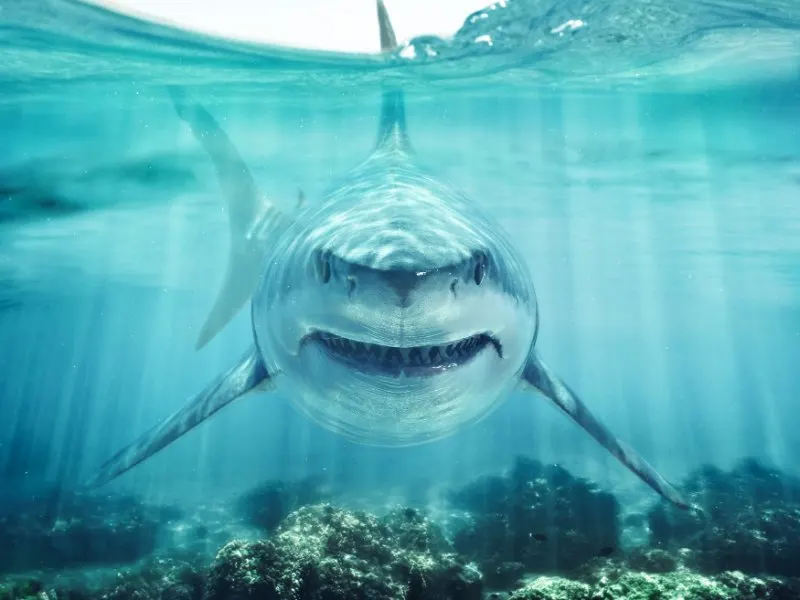
Here’s a list of the white shark species.
- Basking shark. Basking sharks are the second-largest fish in the world and can weigh up to ten tons. They are a harmless filter feeder and can be found in coastal waters all over the world. Despite their size, they are not considered a threat to humans. They are often seen swimming near the surface. Their large dorsal fin and tail stick out of the water.
- Mackerel sharks. Mackerel sharks are a type of Great White Shark, and they fall under the category of an endangered species. Their population is approximately 3,500 individuals, and they are mainly found in the Pacific and Indian oceans. Mackerel sharks are known for their size, powerful jaws, and sharp teeth.
- Juvenile white sharks. Juvenile white sharks are a species of Great White Shark. Great white sharks are known for their size, powerful jaws, and sharp teeth. Juvenile white sharks are those that have not reached maturity. Great white sharks take a long time to reach maturity and are not considered adults until they are about 10-12 feet long.
See Related: Five-Letter Animals to Know Around the World
Great White Shark Facts
Here are some interesting facts about Great White Shark
- The white shark is the largest predatory fish in the sea.
- These sharks can weigh up to 2,500 pounds and reach a size of 20 feet long. The white shark has a powerful bite that can generate 3,000 pounds of pressure per square inch.
- The white shark can swim up to 25 mph. The Great White is not born with its iconic white coloring.
- Great white sharks are born a dark brown or black color, and their coloring changes as they mature.
- The young white shark primarily eats fish. As they grow into adult white sharks, they can also consume sea turtles, sea lions, seals, dolphins, and even small whales.
- The white shark has been known to attack humans, but this is rare.
- When the white shark bites, it moves its head from side to side. This increases the bite force, allowing the teeth to cut off enormous chunks of meat.
- The white pointer has the greatest bite force on earth.
- White sharks, along with other mackerel sharks and thresher sharks, are endothermic or warm-blooded. They have the capacity to keep some portions of their body at temperatures higher than the surrounding water.
- Despite its name, the top of a white shark is actually dark gray or brown. Their underside is white.
See Related: Fun, Interesting Facts About Whales
Conservation Status
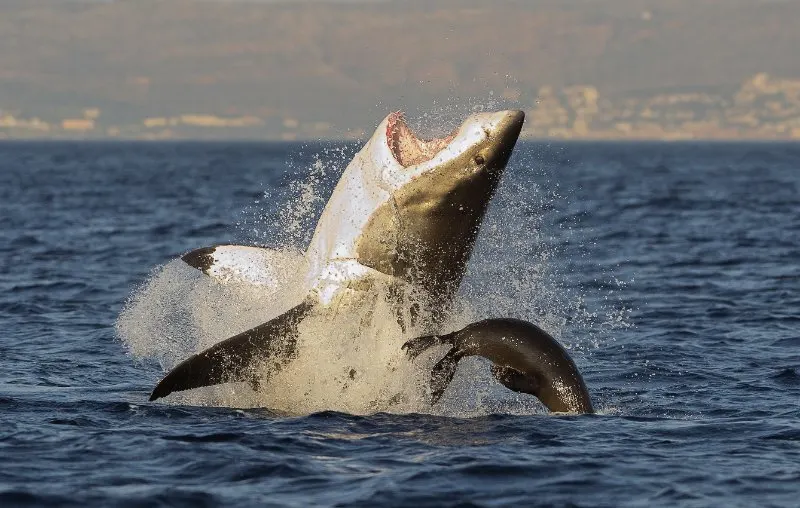
Great white sharks are a vulnerable species due to their low reproductive rate and hunting habits. Great white have been hunted for their meat, skin, and fins for many years. This has led to a decline in the Great white shark population.
Threats
Despite their important role in the ocean’s ecosystem, the white shark is listed as a vulnerable species.
Here are the top threats to the great white shark.
Commercial Fishing
The main reason for this is that Great white sharks are hunted by humans. Great white shark is also killed when they accidentally get caught in fishing nets. Habitat destruction is also a major threat to Great white sharks.
Great white sharks are often caught and killed as bycatch. They are not the target of the fisherman but are caught unintentionally. These predatory sharks are also hunted for their meat, skin, and fins.
Human hostility is the chief threat to the great white shark. This includes hunting for meat and trophies as well as “revenge killings.” This often follows a well-publicized shark attack or even a shark attack movie.
Fishing for sharks is usually carried out by individual shark fishermen rather than on a commercial scale. The edible fins are one target of sport fishing and trophies such as the teeth or jaws being another.
Since sharks put up a good fight and there is a slight whiff of danger to the fishing, the excitement of the sport is also a lure. Sharks are also caught and killed accidentally in fishing nets, especially gill nets.
See Related: What is Overfishing? Examples & Solutions to Prevent
Shark Culling
Governments often resort to shark culling, sometimes known as “shark control.” This is an effort to decrease shark attacks. Environmentalists and scientists have voiced their disapproval of these initiatives. Shark culling has a negative impact on the marine ecosystem. The use of shark nets and drum lines means that many other marine animals (dolphins, turtles, etc.) are killed in these programs as well.
Current “shark control” (shark culling) initiatives in both Queensland and New South Wales involve the killing of great white sharks. While New South Wales only employs nets, Queensland employs both nets and drum lines with baited hooks. About 50,000 sharks, mostly great whites, were killed by authorities in Queensland between 1962 and 2018.
Great white sharks were among the 667 sharks destroyed by officials in Queensland between 2013 and 2014. When great white sharks are discovered on the drum lines in Queensland and are still alive, they are killed. There were a total of 577 great white sharks caught and killed in nets in New South Wales between 1950 and 2008. 14 great white sharks were killed in New South Wales between September 2017 and April 2018.
Great white sharks and other marine animals are killed as part of a “shark control” campaign in the South African province of KwaZulu-Natal. Over 33,000 sharks, including great whites, were killed in KwaZulu-shark-killing Natal’s operation over a 30-year span.
After 7 individuals died from shark bites along the Western Australian coast between 2010 and 2013, a program was implemented that has become known as the Western Australian shark cull. Great white sharks, bull sharks, and tiger sharks were targeted with baited drum lines set up near popular beaches. When large sharks were found hooked and still alive, they were shot and thrown back into the ocean.
The authorities insisted they were not killing sharks but rather employing a “targeted, localized, danger mitigation method.” The scientific community was largely critical of the government’s drum line policy, demonstrating that the species responsible for bite incidents were notoriously difficult to identify, that the lines were ineffective at capturing white sharks, and that the government lacked evidence linking the policy to a reduction in shark bite incidents.
See Related: Types of Sharks Around the World
Pollution
Great white sharks are considered an endangered species due to various threats, including pollution. Pollution can have a devastating impact on sharks and other marine life. Toxic runoff from factories and farms can contaminate water supplies, making it difficult for sharks and other marine life to survive.
Climate Change
One of the biggest dangers that climate change poses to great white species of shark is the potential for their habitats to shrink. These predatory sharks rely on a few specific areas along the coast to give birth and raise their young, but as global temperatures rise and ocean conditions change, those areas could become unsuitable. As a result, fewer sharks would be born, leading to a population decline.
Conservation efforts
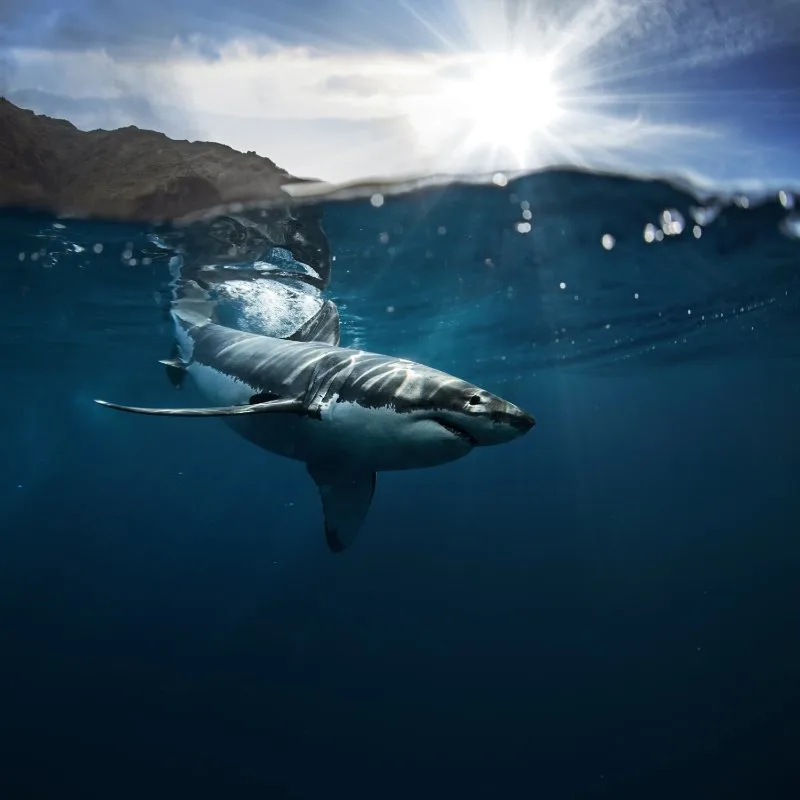
Many conservation organizations focused on the great white shark are now active, such as the White Shark Trust and others. These organizations promote protection measures for sharks and also educate the public about these large marine predators.
Many conservation efforts focus on making people less hostile to sharks and building an understanding of their role in nature.
There are many things we can do to help protect Great White Sharks from becoming extinct. Some of these things include:
- Providing financial support to research and conservation organizations
- Raising public awareness about the plight of Great white sharks
- Promoting responsible fishing practices that don’t harm Great White Sharks
- Working with local governments to establish marine protected areas where Great White Sharks can live and breed safely
See Related: Best Wildlife Conservation Jobs
Organizations
Dyer Island Conservation Trust

The Dyer Island Conservation Trust works to protect the marine ecosystem around the Western Cape in South Africa and a number of marine animals and birds in the area.
It is an organization that has been working tirelessly to achieve this goal by implementing various research and conservation programs.
Some of these programs include studying the behavior and ecology of white sharks, conducting migration research, and working with the community to create awareness about the importance of these apex marine mammals and predators.
The organization has also been working on a program to tag Great White Sharks in order to study their migration patterns. The hope is that this information will help us better understand and protect these animals.
Monterey Bay Aquarium
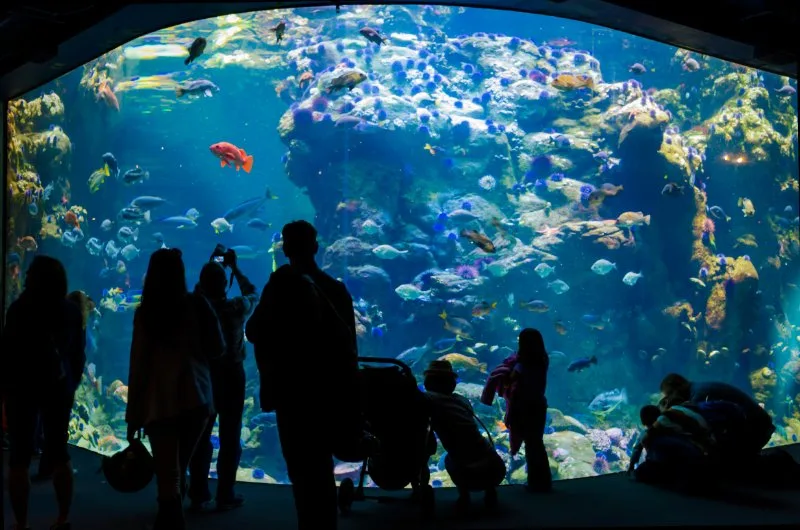
Monterey Bay Aquarium is a not-for-profit public aquarium located in Monterey, California. The aquarium was founded on October 20, 1984. The aquarium’s mission is to “inspire conservation of the oceans.” The aquarium is also home to the largest Great White Shark on display in the world.
Monterey Bay Aquarium conducts research projects and tagging to study migration, habitats, diets, and populations and protect different marine species like the Great White Sharks.
Oceana

Oceana is a nonprofit ocean conservation organization that is dedicated to protecting and restoring the world’s oceans. Oceana focuses on issues such as overfishing, pollution, climate change, and many other threats to the ocean. Great white sharks are one of the animals that Oceana is working to protect.
Oceana is the largest international organization focused only on ocean conservation and protecting marine ecosystems and endangered species.
World Wildlife Fund
The World Wildlife Fund is one of the primary organizations that are working on wildlife conservation including Great White Sharks.
The fund has been able to work with various governments and agencies to provide a better understanding of the Great White Shark. The WWF has also been able to work with local communities in order to create a better understanding of sharks and their role in the ecosystem.
See Related: Famous Environmentalist Leaders
Final Thoughts
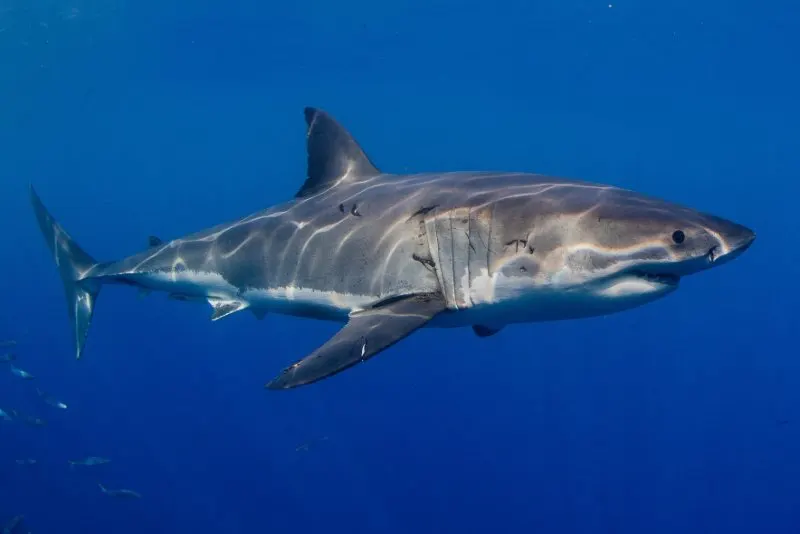
Great White Sharks are a type of shark that is known to be a vulnerable species. Great white sharks often have their fins cut off due to the high demand in Asia for shark fin soup, which has caused many Great whites to become extinct.
Great whites also eat seals and sea lions on occasion when they swim near land, so humans hunt them down as revenge. Sharks are also unintentionally killed as a result of fishing practices. While many people fear these magnificent creatures due to their reputation as man-eaters or because they appear on television shows, there is no need to worry about shark attacks while swimming at your local beach.
Despite the efforts of many conservation organizations, Great White Sharks are still declining in population.
There are many things we can do to help Great White Sharks, such as providing financial support to research and conservation organizations, raising public awareness about the plight of Great white sharks, and promoting responsible fishing practices that don’t harm Great White Sharks.
We can also work with local governments to establish marine protected areas where Great White Sharks can live and breed safely. By working together, we can help Great White Sharks stay off of the endangered species list.
Other Species Profile
Related Resources
- Celebrity Environmentalists
- Do Bulletproof Animals Exist? Here’s What You Need to Know
- Ways to Save Animals Facing Extinction
FAQ
What is the Great White Shark?
The great white shark (Carcharodon carcharias) is a large, ferocious species that can reach lengths of up to 21 feet.
They are found in all seas throughout the world. However, they prefer temperate and cold water. Great white sharks feed on a variety of foods, including fish, seals, and sea turtles. They have been seen to scavenge meat from whale carcasses.
How big do Great White Sharks get?
Great white sharks can grow to be up to 21 feet long and weigh more than 2,000 pounds. Great white sharks are the largest predatory fish in the ocean. Sharks have a lifespan of about 70 years.
Are Great White Sharks endangered?
No, Great White Sharks are vulnerable. Their population is less than 3,500 individuals throughout the world.
What is the Great White Shark diet?
Great White Sharks are known to have a wide diet, but their diet mainly consists of smaller fish, octopuses, and crabs.
Great white sharks also prey on seals when the opportunity arises because seals provide more caloric energy per bite than any other Great White Shark prey species. Great white sharks from different regions show preferences for different prey, so this is not a monolithic species.
Great white sharks have a fearsome reputation, but they are not the indiscriminate killers that many people think they are.
Great white sharks prefer to attack prey from below, using their powerful jaws to grasp prey before shaking it violently until it is dead.
How can we help protect Great White Sharks?
There are a few things we can do to help protect Great White Sharks. Some of these things include:
– Educating people about the importance of sharks and their role in the ecosystem
– Working to reduce fishing pressure on these marine animals
– Banning the trade of Great White Shark products
What is the future of Great White Sharks?
Great white sharks are lucky. They are afforded the preservation of this great, beautiful and elegant animal by Great White Shark Campaigners.
Great white sharks face many dangers in today’s society: primarily commercial fishing with longlines and gillnets, finning for their valuable fins, exploitation for use in shark-fin soup, and so on. The future is uncertain for these animals.
Where can Great Whites be seen?
When it comes to seeing Great White Sharks, the waters off the outer beaches of Cape Cod are among the best in the world.
